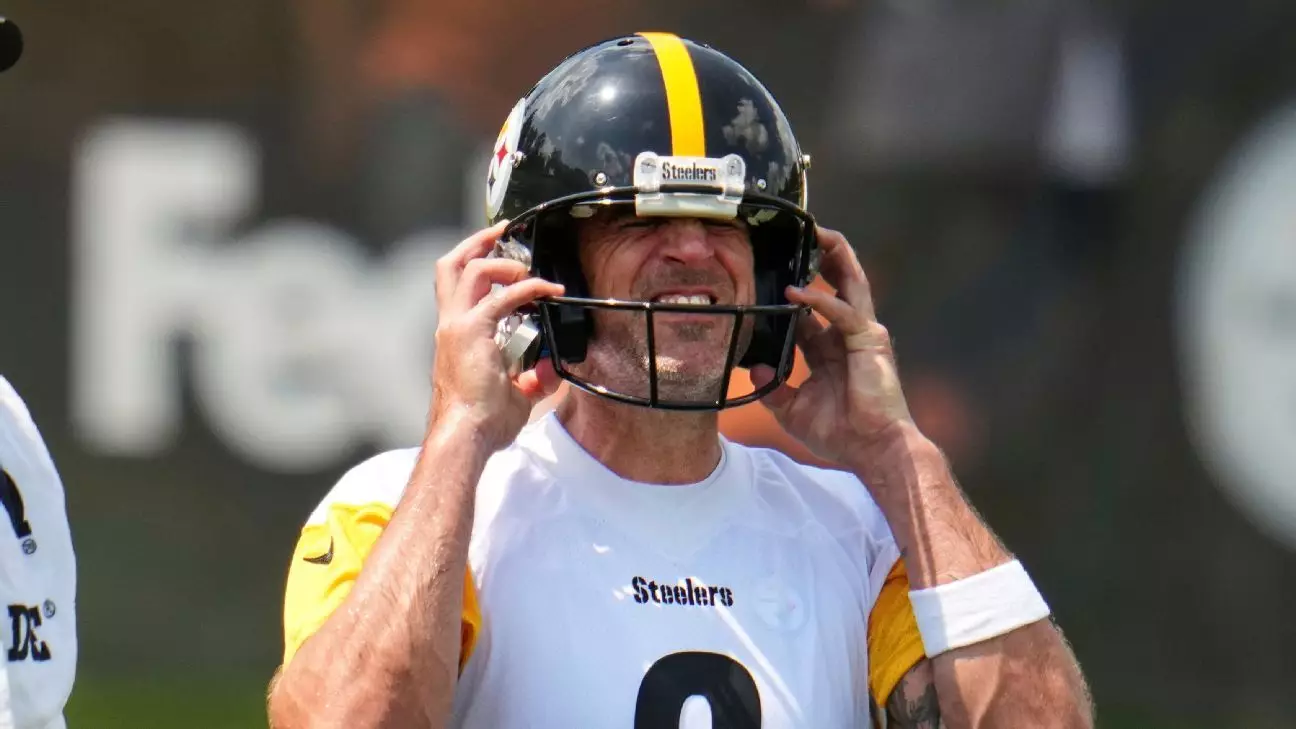Few NFL stories highlight the often overlooked tension between player comfort and evolving safety standards quite like Aaron Rodgers’ ongoing helmet saga. For decades, players have trusted a familiar piece of equipment—an extension of their identity on the field. Rodgers, a seasoned quarterback with a two-decade attachment to Schutt helmets, now finds himself entangled in a safety protocol overhaul that denies him his preferred gear. The ban of the Schutt Air XP Pro Q11 LTD, once a staple in his equipment arsenal, exposes a broader challenge: balancing player comfort with uncompromising safety regulations.
What’s revealing here isn’t just Rodgers’ frustration but the deeper philosophical debate about athlete agency versus league mandates. Players tend to resist change, especially when it disrupts their rhythm and comfort. Rodgers’ comments — comparing the new helmet to “a damn spaceship” — underscore not merely discomfort, but a resistance rooted in familiarity and trust. Safety innovation, while vital, often collides with athletes’ personal sense of efficacy and familiarity, raising questions about how responsible leagues are in easing such transitions.
More critically, this situation exemplifies how leagues impose regulatory standards that may alienate the very individuals they aim to protect. Rodgers’ predicament is a microcosm of a larger issue: technological advances in sports equipment constantly evolve, yet athletes’ acceptance hinges on trust, and that trust takes time to build. The league’s mandate for compliance may be necessary from a safety perspective, but the emotional and psychological toll—especially on veteran players—is a nuanced challenge that sports administrators must navigate carefully.
Injury Realities: The Hidden Battle for Athletic Resilience
Football is an unforgiving sport that continually tests the resilience of its players, both physically and mentally. Rodgers’ minor calf injury sustained during practice highlights how even routine incidents can serve as sobering reminders of the sport’s inherent dangers. The image of a star quarterback who has already endured a torn Achilles walking gingerly and then bouncing back speaks volumes about the grit required in the NFL.
However, the injury situation for Rodgers isn’t just about the physical trauma; it’s about the importance of mental toughness amid adversity. Warmed-over fears from previous injuries linger beneath the surface, influencing how players approach each practice or game. For Rodgers, the injury appears minor, but the psychological impact of lingering doubts—whether about health, performance, or recovery—never fully leaves the mind of a seasoned vet. His quick return to full activity after being stepped on reflects a mindset of resilience, but it also underscores the nervousness that accompanies athletic aging.
Meanwhile, rookies like Will Howard face a different type of challenge—an unexpected, freak injury—and are thrust into a crucible of rapid adaptation. Howard’s broken finger, caused by a seemingly innocuous exchange, offers a stark reminder that no matter how well prepared athletes might be, they are all vulnerable to unpredictable mishaps. His decision to avoid surgery and manage the injury conservatively reveals a mindset rooted in patience and the long view. Still, such injuries throw a spotlight on the mental toughness required to stay motivated despite setbacks—a crucial yet often undervalued facet of professional football.
Rookies and Veterans: Different Battles in the Preseason Arena
The contrast between Rodgers’ seasoned resilience and Howard’s rookie vulnerability offers a fascinating dual narrative about what it takes to survive and thrive in the league’s brutal preseason grind. For Aaron Rodgers, the challenge is now more psychological—dealing with equipment discomfort and physical warnings—while trying to establish himself as the Steelers’ leader. His frustrations with helmet discomfort are emblematic of the larger tension between legacy and innovation; he must adapt without losing his sense of self on the field.
In stark contrast, Will Howard’s predicament embodies the harsh reality that rookies face: a steep learning curve where small mistakes or freak accidents can derail their entire season before it even begins. His candid admission of frustration and the acknowledgment that he’s “week-to-week” highlight how fragile the optimism of a rookie can be in the face of adversity. Howard’s attitude—accepting the setback and focusing on recovery—reflects a profound understanding of the mental game, a quality that often separates transient players from long-term ones.
Both stories underscore that resilience isn’t just about physical toughness, but also mental fortitude. Rodgers’ ongoing equipment struggles reveal how even the most experienced players must contend with incremental frustrations that threaten to disrupt their focus. Meanwhile, Howard’s injury expresses how a moment of vulnerability can serve as a turning point—either as a setback or an opportunity for growth—depending on how players choose to respond.
Beyond the Surface: The Psychological Toll of Football’s Unseen Battles
What perhaps remains unspoken amid these injuries and equipment debates is the psychological resilience required to navigate the intense pressures of the NFL season. Rodgers’ visible frustration with his helmet isn’t just about discomfort; it’s symbolic of the battle to maintain confidence when routine aspects of the game are altered. Loyalty to comfort and familiarity plays a significant role in athletes’ self-beliefs, and challenges against these norms can shake their mental foundations.
For rookies like Howard, the anxiety of an unforeseen injury compounds the intense pressure to perform. His awareness of being “week-to-week” burns a hole in his confidence, yet he carries an admirable attitude of perseverance. The mental game, often overshadowed by physical prowess, is perhaps the most critical factor determining whether a player can sustain success over the long haul.
The NFL’s culture of relentless competition, combined with the physical hazards of the sport, creates an environment where resilience must be cultivated continually. Both Rodgers and Howard exemplify different facets of this necessity: one mired in frustration but determined to adapt, the other in pain but committed to recovery. Their experiences remind us that behind every headline are invisible battles—those fought within the mind—that ultimately define a player’s career trajectory.


Leave a Reply